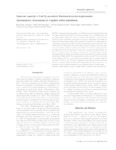Use este identificador para citar ou linkar para este item:
http://www.alice.cnptia.embrapa.br/alice/handle/doc/1061874| Título: | Dispersal capacity of fruit fly parasitoid Diachasmimorpha longicaudata (Hymenoptera: Braconidae) in irrigated coffee plantations. |
| Autoria: | CAMARGOS, M. G.  ALVARENGA, C. D.   GIUSTOLIN, T. A.   PARANHOS, B. A. J.   OLIVEIRA, P. C. do C.   RABELO. M. M.   |
| Afiliação: | MARIA GISELY CAMARGOS, State University of Montes Claros, Janaúba, MG; CLARICE DINIZ ALVARENGA, State University of Montes Claros, Janaúba, MG; TERESINHA AUGUSTA GIUSTOLIN, State University of Montes Claros, Janaúba, MG; BEATRIZ AGUIAR GIORDANO PARANHOS, CPATSA; PATRÍCIA CRISTINA DO CARMO OLIVEIRA, State University of Montes Claros, Janaúba, MG; MARCELO MENDES RABELO, State University of Montes Claros, Janaúba, MG. |
| Ano de publicação: | 2016 |
| Referência: | Scientia Agrícola, v. 73, n. 3, p. 227-233, 2016. |
| Conteúdo: | Diachasmimorpha longicaudata is an Old World parasitoid of tephritid fruit flies that was widely introduced in the Americas to control pest species such as the Mediterranean fruit fly Ceratitis capitata. Augmentative releases in irrigated coffee plantations in semiarid regions of Brazil are under consideration and dispersal capacity of D. longicaudata in this habitat are important to develop release strategies. Approximately 2,000 individuals of D. longicaudata (5 to 7 days old) were released in the center of a fruiting coffee plantation every two weeks from Dec. 2009 to Apr. 2010. Dispersal from the central release point was monitored to the north, south, east, west, northeast, northwest, southeast and southwest at 11 distances, beginning at 4.6 m and ending at 90 m from the release point. At each point, a parasitism unit (approximately 120 larvae of C. capitata in the 3rd instar wrapped in voile fabric) and 10 coffee beans were collected. The average dispersion distance and dispersion area were estimated by the model proposed by Dobzhansky and Wright (1943). The average dispersion distances were 27.06 m (as estimated by fruit collection) and 33.11 m (as estimated by oviposition traps). The average dispersion areas were 1,315.25 m 2 and 1,752.45 m2 originating from the collection of beans and parasitism units, respectively. Cohorts of 2,000 adult D. longicaudata released at six points ha−1 are estimated to result in sufficient colonization to exert significant control of Ceratitis capitata. |
| Thesagro: | Controle biológico Café Ceratitis Capitata |
| NAL Thesaurus: | Diachasmimorpha longicaudata |
| Palavras-chave: | Mosca-das-frutas |
| Digital Object Identifier: | 10.1590/0103-9016-2014-0343 |
| Tipo do material: | Artigo de periódico |
| Acesso: | openAccess |
| Aparece nas coleções: | Artigo em periódico indexado (CPATSA)  |
Arquivos associados a este item:
| Arquivo | Descrição | Tamanho | Formato | |
|---|---|---|---|---|
| Beatriz2016.pdf | 433,23 kB | Adobe PDF |  Visualizar/Abrir |









